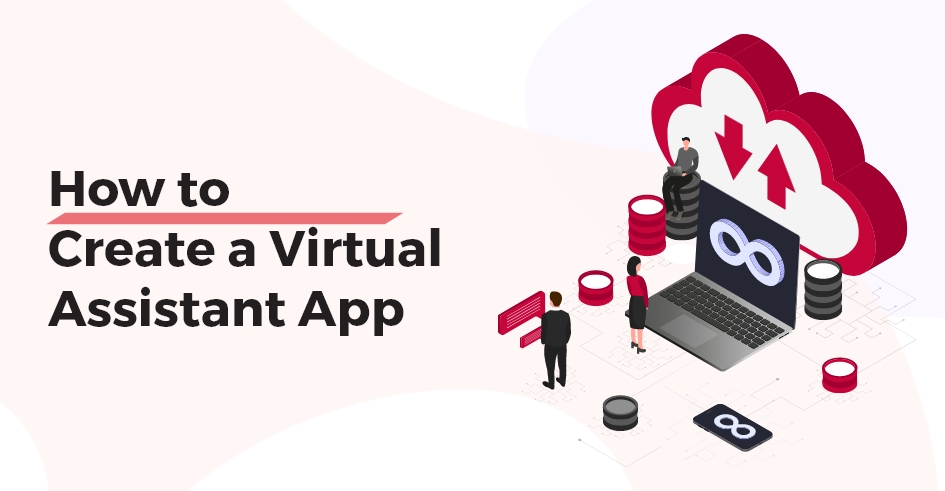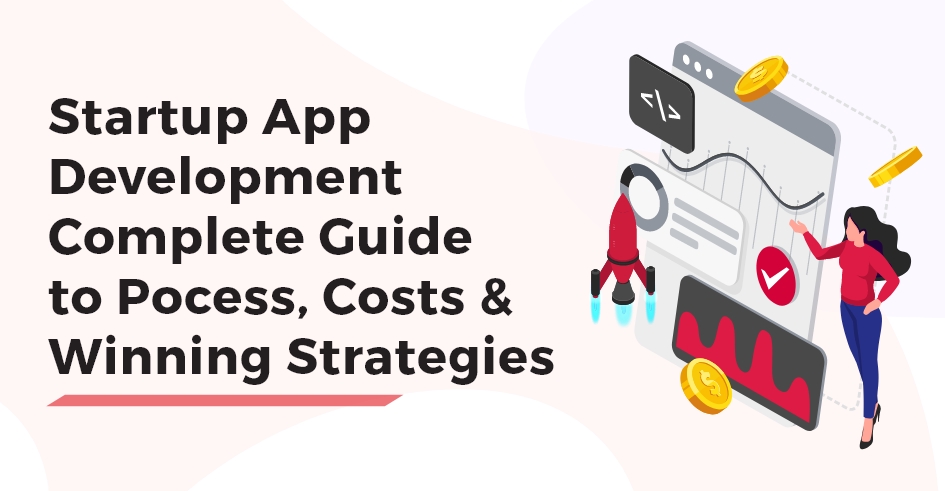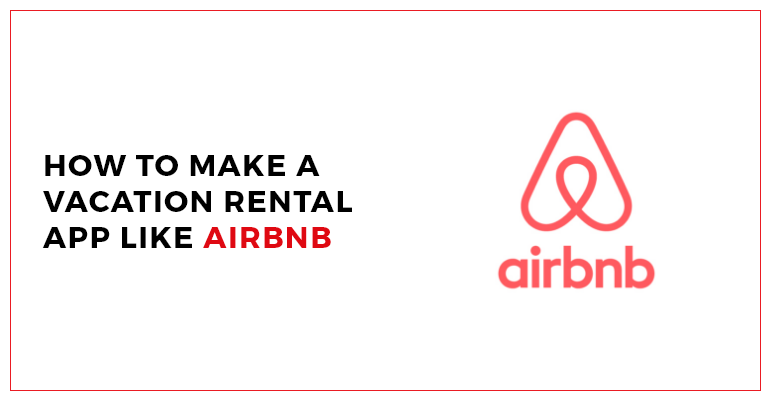Its 2024, we rely on technology to handle tasks, answer questions, manage our lives, do bank transactions and what not. Virtual assistant apps come in handy to manage all of these for us. They’re like having a personal assistant in your pocket—ready to help at the tap of a screen.
Investing in a AI virtual assistant app isn’t just about staying trendy; it’s about solving real problems. Be it managing your schedule, streamlining communication, or even monitoring your health, these apps have revolutionized how we operate day to day.
And guess what? The demand for them is skyrocketing. Statista says that The market for intelligent virtual assistants is projected to achieve a value of $129.61 billion by the year 2032. From Amazon’s Alexa to Google Assistant, these digital helpers are part of an everyday tech toolkit. If you’re thinking of building your own, now’s the perfect time.
In this post, we’ll dive into everything you need to know about building your own virtual assistant app in 2024. So let’s get started!
What is a Virtual Assistant App?
A virtual assistant app is a software application that uses artificial intelligence (AI) to perform tasks or services for individuals based on their voice commands or text inputs. These apps are designed to assist users with a wide range of tasks, such as setting reminders, answering questions, managing schedules, sending messages, controlling smart home devices, or even making recommendations.
Best virtual assistant app assistants like Siri, Google Assistant, and Amazon Alexa, all of which offer personalized assistance by learning from user behavior and preferences.
Why Invest in a Virtual Assistant App?
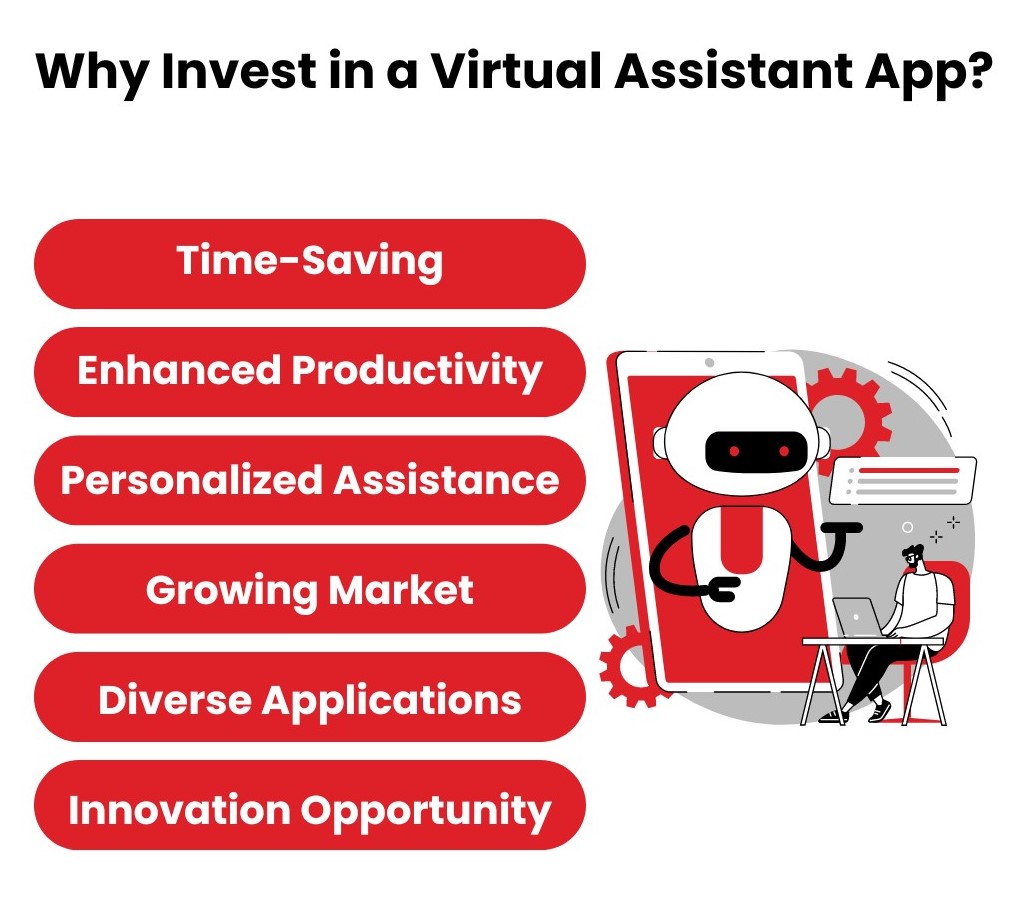
Imagine a world where you no longer have to manually manage schedules, answer emails, or even remind yourself to buy milk. Enter the virtual assistant app—a personal assistant on your smartphone that handles mundane tasks while you focus on more important things, like binge-watching your favorite Netflix series or beating your high score on Candy Crush. With the rise of remote work and smart homes, the demand for voice assistant app development is skyrocketing.
Virtual assistants like Siri, Google Assistant, and Alexa have paved the way, but there’s plenty of room for new, innovative players in the market. For instance, consider a virtual health assistant app. This type of app can track your fitness goals, remind you to take medications, schedule doctor appointments, and even provide real-time health tips based on your activity levels.
By investing in a virtual health assistant app, you’re not just jumping on a tech trend—you’re creating a tool that can enhance well-being and improve daily life for users. So, if you’re thinking of building a AI virtual assistant app, now is the perfect time to dive in and make a significant impact.
What Virtual Assistants Do and the Challenges They Face
Virtual assistants are like the best co-workers you could ever have—minus the small talk and coffee breaks. A virtual assistant app can help you with:
- Scheduling meetings
- Setting reminders
- Sending messages or emails
- Managing to-do lists
- Answering common questions
- Controlling smart home devices
For mobile app development companies in Dallas, an AI virtual assistant app could handle basic customer inquiries, freeing up time for more complex tasks.
Virtual Assistant App Challenges
However, creating a virtual assistant app isn’t as simple as teaching it to say, “Hello, world!” The primary challenge lies in enabling the app to understand human language. Natural Language Processing (NLP) and Machine Learning (ML) are essential for your virtual assistant to interpret various accents, dialects, and even sarcasm (though teaching an AI to understand sarcasm is like asking your cat to do your taxes).
Moreover, ensuring data privacy and security is crucial. No one wants a virtual assistant that’s eavesdropping on private conversations or leaking sensitive information. Ensuring encryption and compliance with data privacy laws will be key to the success of your app.
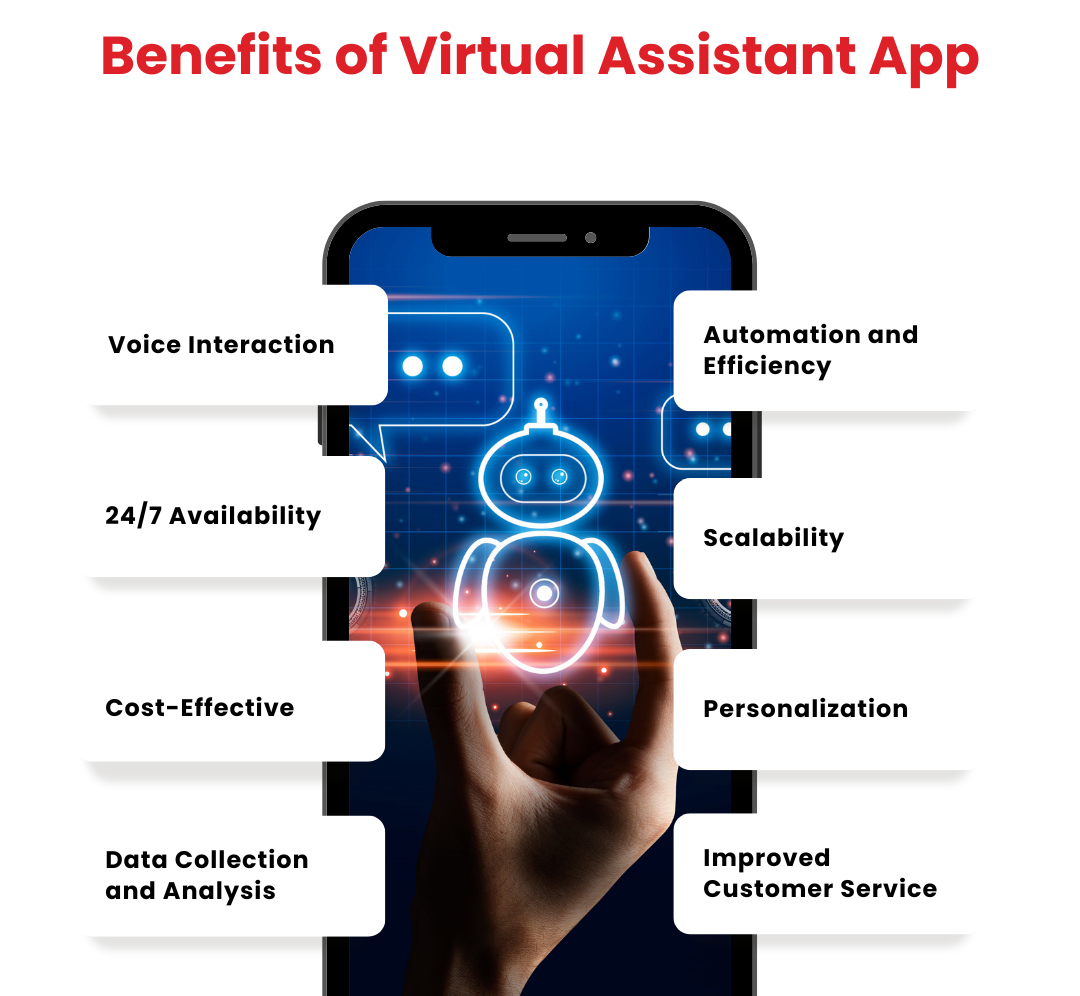
Benefits of Virtual Assistant App
If you’re still on the fence about whether to invest time and resources into building a virtual assistant, let’s talk benefits:
Automation and Efficiency
Virtual assistants automate repetitive tasks, saving both individuals and businesses valuable time. For example, instead of hiring someone to schedule meetings, a virtual assistant app can do it automatically.
24/7 Availability
Unlike human assistants who need sleep (lazy, right?), virtual assistants are available around the clock. Whether it’s 3 AM or 3 PM, your assistant can perform tasks when needed.
Personalization
Virtual assistants can learn user preferences over time, providing more personalized and efficient assistance. Imagine having an assistant who knows you like your coffee black and your meetings short—no more unwanted 2-hour Zoom calls!
Cost-Effective
Hiring human employees comes with salary, benefits, and training costs. Virtual assistant apps, on the other hand, offer a one-time development cost (plus maintenance), saving businesses thousands in the long run. For small businesses, this is a game-changer! Think of it as having a dedicated assistant who works tirelessly without asking for a paycheck—or coffee breaks. The cost-effective nature of virtual assistants, you can also implement app monetization strategies to help you profit from the app.
Scalability
As your business grows, so can your virtual assistant. A well-built virtual assistant app can handle increasing volumes of tasks without breaking a sweat. No need to hire multiple assistants when your app can scale to meet the growing demands of your business. You could say it’s the Superman of task management!
Improved Customer Service
Virtual assistants can provide quick, consistent responses to customer inquiries, improving customer satisfaction. This helps businesses respond faster to clients, without the risk of human error or exhaustion. If you’ve ever dealt with grumpy customer service reps, you know how valuable this can be!
Data Collection and Analysis
Virtual assistants are great at collecting data about user behavior and preferences. With AI and machine learning, the app can analyze this data to improve services over time. This means smarter recommendations, better user experiences, and a data-driven approach to improvement. It’s like having a data analyst baked right into your assistant!
Voice Interaction
Let’s face it—typing is so 2020. Today, voice interaction is the future. With voice recognition tech improving every day, virtual assistants can handle tasks just through voice commands. It’s like having your very own “Jarvis” from Iron Man but in your pocket. No suits of armor required!
How to Create a Virtual Assistant App
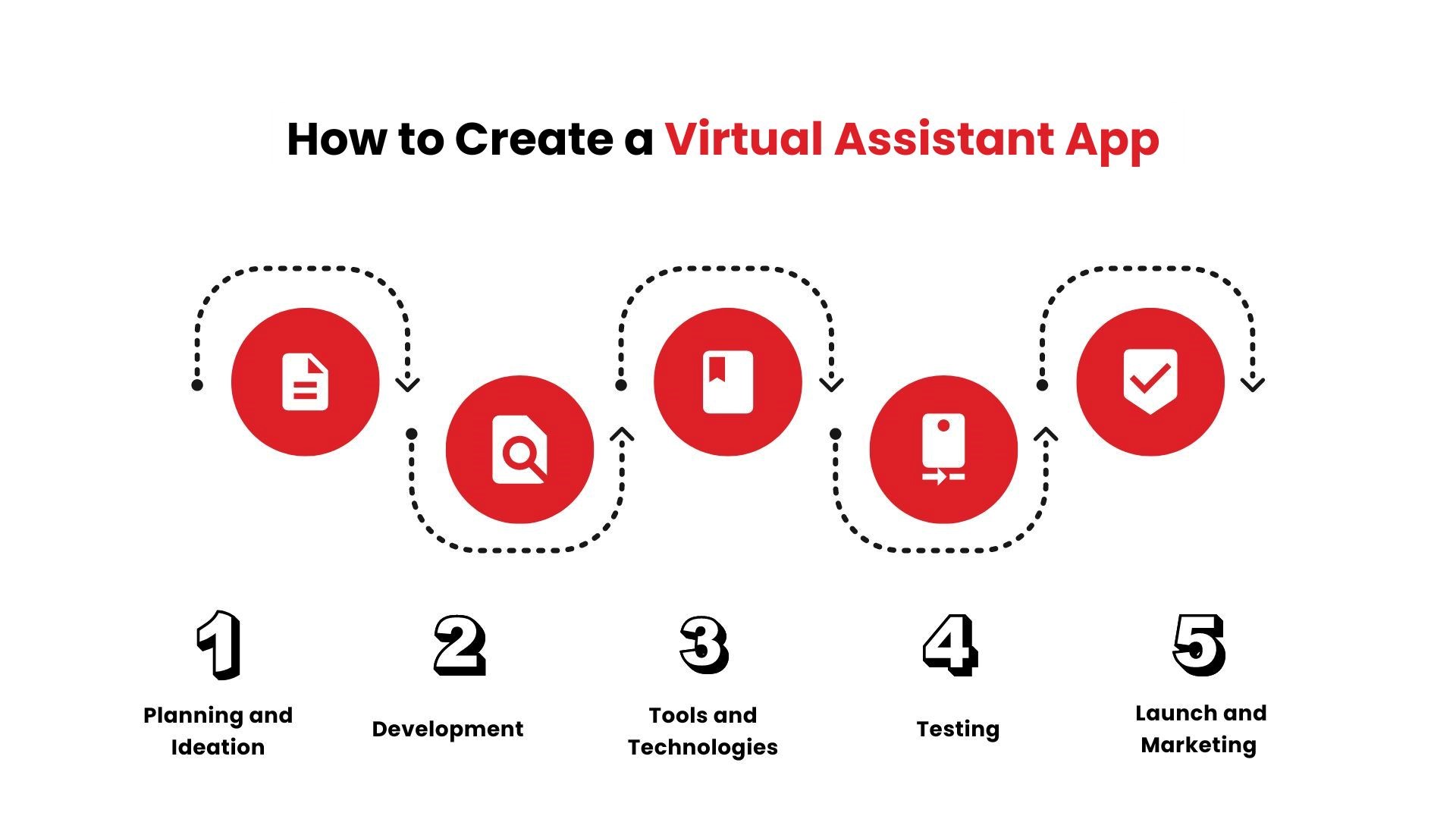
To create a Virtual Assistant App follow these steps:
- Planning and Ideation
- Development
- Tools and Technologies
- Testing
- Launch and Marketing
Now, let’s break down the process of how to create a virtual assistant into manageable steps:
1. Planning and Ideation
Before jumping into development, it’s crucial to outline the goals of your app. Who is your target audience? Is it for businesses, personal use, or both? What problems will your app solve? During this stage, decide on the primary features your AI virtual assistant app will offer, such as task scheduling, voice commands, or integration with other apps.
Example: If you’re creating a personal assistant app for remote workers, think about features like calendar management, file sharing, and integration with platforms like Slack or Zoom.
2. Development
This is where the magic happens. You’ll need to choose the right technology stack for your app. Here are some key technologies:
- Natural Language Processing (NLP): Allows your app to understand and interpret user commands.
- Machine Learning (ML): Helps the app learn from user behavior and improve its responses.
- Cloud Computing: Enables the storage of massive data sets and allows for real-time interaction with the app.
Looking to develop your virtual assistant app for iOS? Let TechnBrains’ iOS app development experts guide you through creating a seamless experience on Apple devices.
3. Tools and Technologies
To build a virtual assistant, you’ll need a combination of advanced tools and technologies. Let’s break them down:
- Natural Language Processing (NLP): Libraries like SpaCy or Google’s Dialogflow can help your app interpret human language.
- Machine Learning (ML): TensorFlow and PyTorch are excellent for integrating machine learning algorithms.
- Voice Recognition: Google’s Speech-to-Text API or Apple’s SiriKit are great for developing voice functionalities.
Imagine using these technologies to build virtual assistant capabilities that allow users to control smart home devices or manage emails, all through voice commands.
It’s worth noting that platforms like Amazon Web Services (AWS) and Google Cloud offer solutions for voice assistant app development and can drastically speed up the process.
Pro Tip: Start with a Minimum Viable Product (MVP)—a basic version of your app with essential features. You can add more bells and whistles later.
Ready for cutting-edge AI for your virtual assistant app? Explore how TechnBrains’ artificial intelligence services can bring your ideas to life!
4. Testing
Testing is critical. You want to ensure your app works seamlessly across different devices and understands various accents and speech patterns. Conduct beta tests with real users and collect feedback to fine-tune the app’s performance. No one wants a virtual assistant that schedules a meeting when you ask it to set a reminder!
5. Launch and Marketing
Once your app is fully developed, it’s time to launch! But don’t just drop it in the app store and hope for the best. Create a marketing strategy to attract your target audience. Utilize social media, email campaigns, and maybe even a quirky YouTube video that shows your virtual assistant app in action. (Because who doesn’t love a fun promo video, right?)
Best Practices to Create a Virtual Assistant App
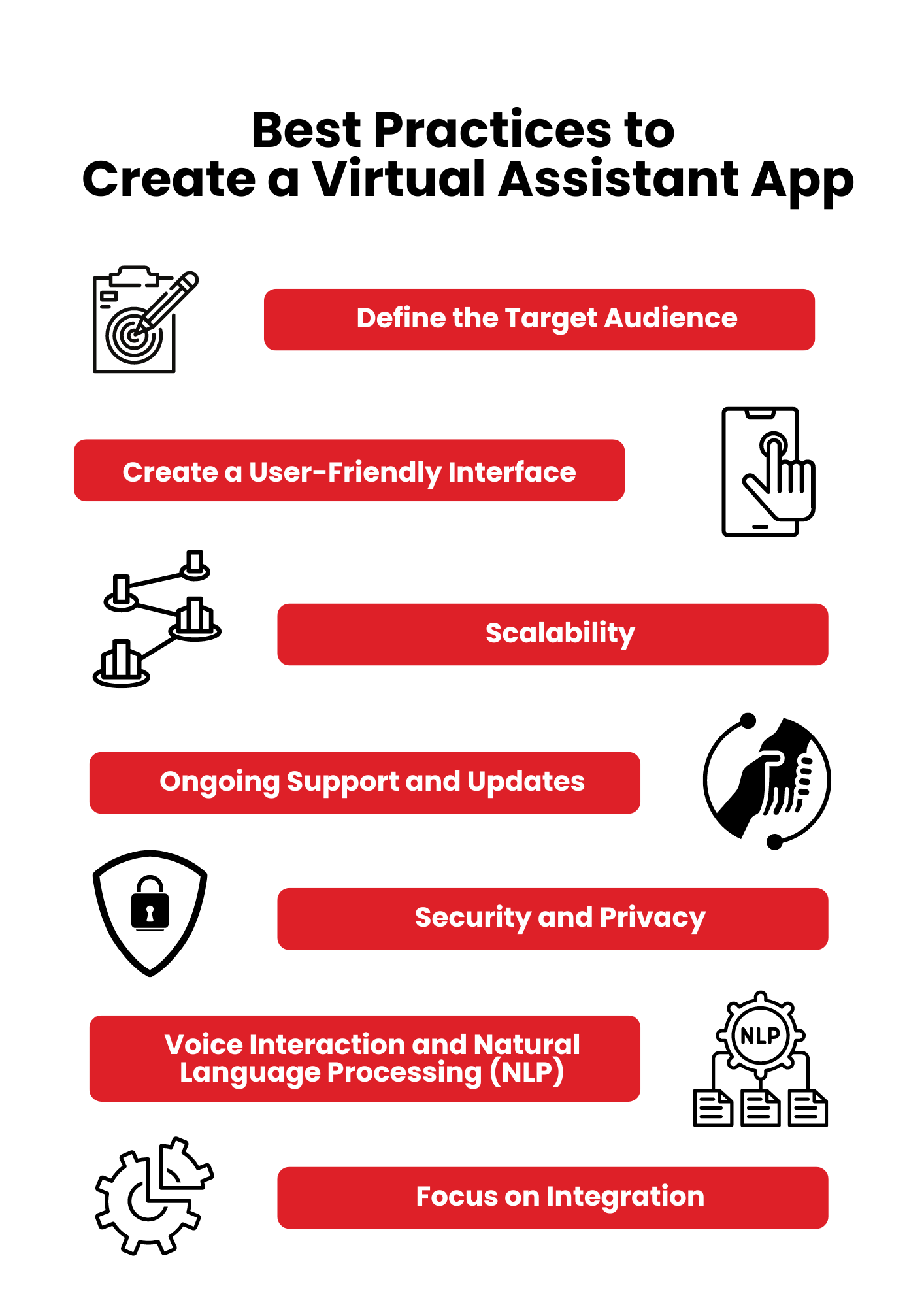
Creating a virtual assistant app isn’t just about throwing together some code and calling it a day. To truly make an impact in a crowded market, your app needs to stand out by offering not only excellent functionality but also a seamless user experience. Below are some best practices that can help ensure your virtual assistant app achieves lasting success:
1. Define the Target Audience
Before writing a single line of code, you need to answer a key question: Who is this app for?
Knowing your target audience is the foundation of building a successful app. If you’re designing a virtual assistant for business users, it may need to focus on task management, scheduling, and integration with tools like Slack or Google Workspace.
On the other hand, a virtual assistant app for personal use might focus more on reminders, shopping lists, or even fitness goals.
Think of how Apple’s Siri and Amazon’s Alexa differ. Siri is integrated tightly into Apple’s ecosystem, focusing on personal tasks like sending texts, setting alarms, or controlling smart home devices.
Alexa, while also used for personal tasks, offers features that make it more compatible with home automation and even business applications. Your app needs the same level of thoughtfulness in targeting its audience.
2. Create a User-Friendly Interface
One of the most critical aspects of a successful virtual assistant app is ease of use. No matter how intelligent or powerful the app is behind the scenes, if users find it confusing or difficult to navigate, they won’t stick around.
Your interface should be clean and intuitive. If it takes more than a few seconds to figure out how to perform a task, your users may move on to a competitor. Consider the “one-thumb rule,” where all actions should be accessible with just a single thumb. This helps users—especially those less tech-savvy—get comfortable with the app quickly.
Remember when Netflix redesigned its app to be simpler? Users could now navigate with just a thumb swipe, making it effortless to binge-watch their favorite shows. That level of simplicity is what you should aim for.
As Steve Jobs famously said, “Simple can be harder than complex, but it’s worth it in the end.”
3. Scalability
Your virtual assistant app might start with a small user base, but if you’re aiming for success, you need to think big. Scalability is crucial to ensure that your app can handle more users, features, and data without compromising performance.
One of the most effective ways to ensure your app is scalable is by leveraging cloud services such as AWS, Google Cloud, or Microsoft Azure. These platforms allow you to scale resources as your user base grows, ensuring that your app can handle the increased load without crashing.
Example: Think of how apps like Zoom were able to scale during the COVID-19 pandemic. Suddenly, millions more users were flocking to the platform, and their infrastructure had to scale almost overnight to handle the demand. Your virtual assistant app should be ready for its own explosion of users.
4. Ongoing Support and Updates
Once your app is live, the work doesn’t stop there. In fact, ongoing support and regular updates are vital to your app’s long-term success. The tech landscape is always changing—whether it’s improvements in AI, new machine learning models, or evolving user expectations. Your app needs to stay fresh and relevant by continuously updating its features, fixing bugs, and improving performance.
Implement new technologies like voice interaction improvements, natural language processing (NLP) advancements, and AI-driven predictions to stay ahead of the competition. Users will appreciate the ongoing improvements and stay engaged with your app.
Imagine if Microsoft had stopped updating Windows after version 95—today’s generation would be struggling with slow, outdated systems. Similarly, your app must evolve over time to stay competitive.
5. Security and Privacy
Virtual assistant apps often deal with sensitive data, from personal information to confidential business details. Ensuring that your app has strong security and privacy features is critical to gaining and maintaining user trust.
Make sure all user data is encrypted, both at rest and in transit. Add multi-factor authentication (MFA) to enhance security, especially for business users.
Remember the massive data breaches at companies like Equifax? Events like that show how disastrous weak security can be for a company’s reputation. By ensuring that your app is secure from the get-go, you can prevent such catastrophes and safeguard your users’ trust.
6. Voice Interaction and Natural Language Processing (NLP)
Virtual assistant apps rely heavily on voice interaction and Natural Language Processing (NLP) for interpreting user commands and responding appropriately. Voice recognition needs to be highly accurate and responsive for a virtual assistant to be effective.
Tools like Google Cloud’s NLP API or Microsoft’s Cognitive Services can enhance your app’s ability to understand natural speech patterns and provide intelligent responses.
Google Assistant is a great example of a virtual assistant that continually improves its NLP capabilities. It understands regional accents, context, and even jokes! That’s the level of finesse you should aim for in your app.
7. Focus on Integration
Your virtual assistant app should be able to integrate with other apps and services that your target audience uses daily. Whether it’s integrating with email, calendars, smart home devices, or CRM systems, seamless integration will increase the app’s utility and make it indispensable to users.
Example: Slack bots, which act like virtual assistants within the Slack app, can integrate with third-party apps like Google Drive, Salesforce, and Trello. This seamless connectivity keeps users engaged and ensures long-term success.
Virtual Assistant App Examples
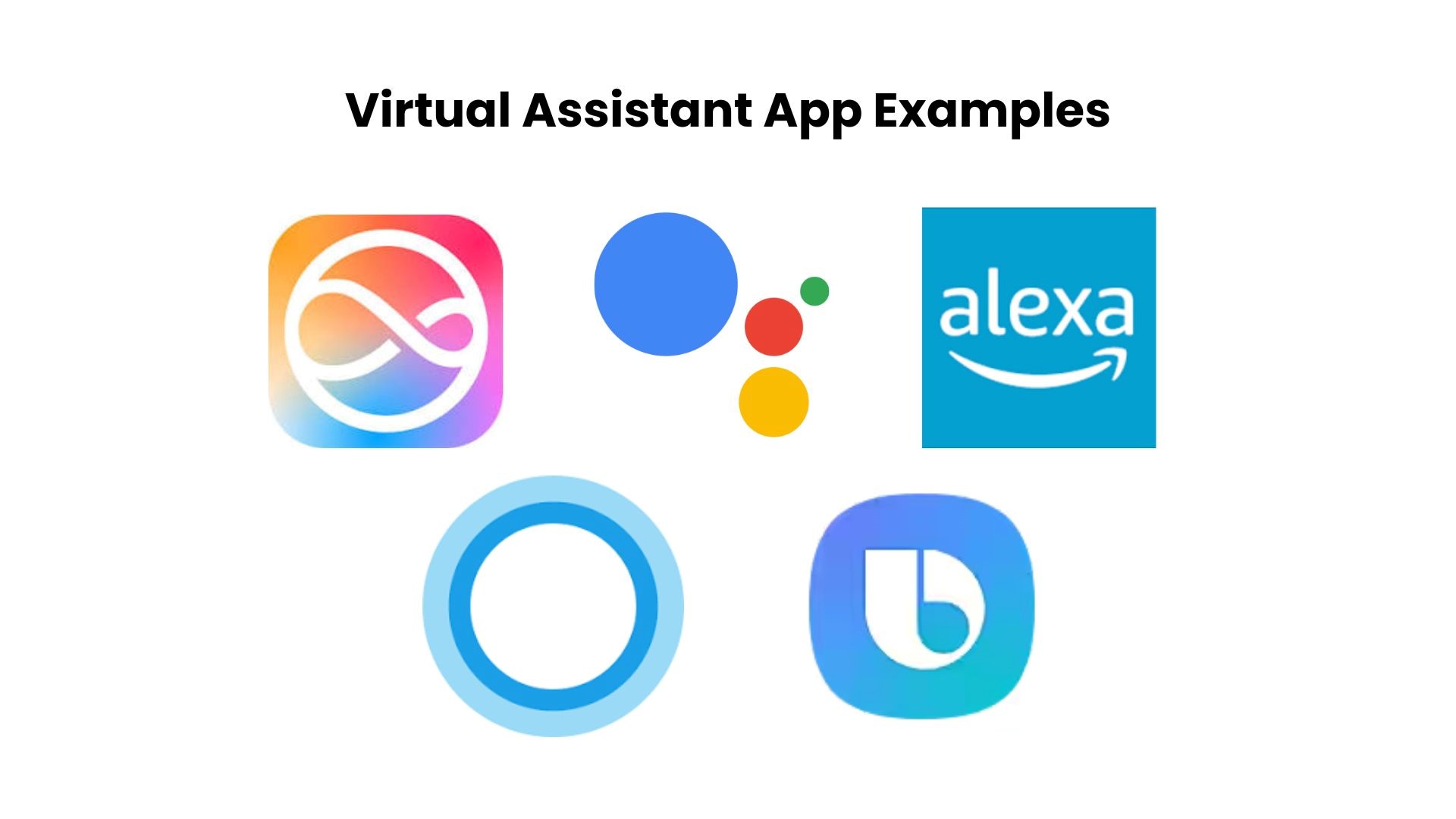
We are going to take a look at the best virtual assistant apps and why they’ve been successful:
- Siri (Apple): Seamless integration with iOS devices and apps. Siri makes managing daily tasks and controlling Apple products effortless.
- Google Assistant: Renowned for its advanced AI and wide range of integrations, Google Assistant is best virtual assistant app for android.
- Alexa (Amazon): Dominates in smart home automation, with extensive compatibility across various smart devices, making home management a breeze.
- Cortana (Microsoft): While less prominent, Cortana integrates well with Microsoft Office and Windows, focusing on productivity and business environments.
- Bixby (Samsung): Known for its deep integration with Samsung devices and unique features like image recognition and device control.
The success of these apps boils down to their ability to continuously evolve, adapt to user needs, and offer reliable service.
Discover how TechnBrains’ expert Android app development team can help build the best virtual assista nt app for Android!
Lets Make The Best Virtual Assistant App With TechnBrains
In 2024, creating a virtual assistant app is not just a fun project; it’s a smart business move. With advancements in NLP, ML, and cloud computing, the possibilities are endless. Whether you’re building a personal assistant app to help individuals manage their daily tasks or a more complex business-oriented assistant, the future is bright for AI-powered assistants.
So, are you ready to create a virtual assistant app like Siri or Alexa? TechnBrains is here to support your virtual assistant app project from start to finish! The next step is yours to take!


